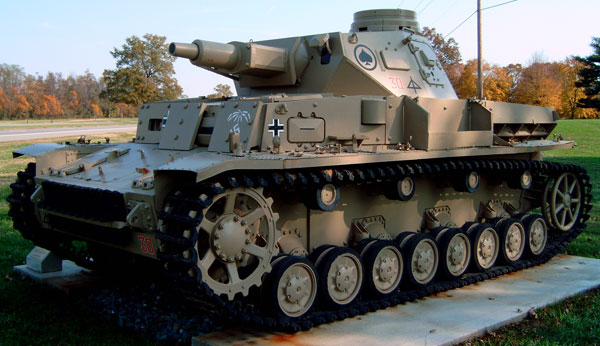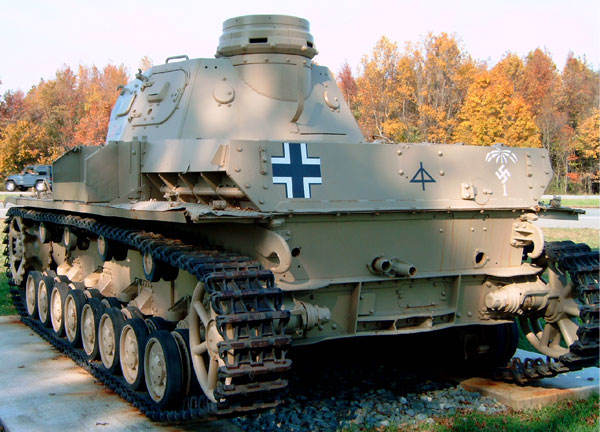|
|
|
Pzkpfw IV
Pzkpfw IV
 This picture shows a good look at the after production bolted
on extra armour at the front of the upper hull.
This picture shows a good look at the after production bolted
on extra armour at the front of the upper hull. |
|
The Panzer Kampfwagen IV was purposely designed to allow for up-grades. Something the allies usually failed to do that rendered most of their tanks obsolete by the early part of the war. These up-grades would be desperately needed as the demand for better armour protection and hitting power was ever increasing. Originally conceived in 1936, the Pzkpfw IV was the only German tank to remain in production throughout World War II. Not as formidable as the Tiger and Panther tanks, none the less, the Pzkpfw IV was the true backbone of Germany's panzer arm due to the fact it was developed into a deadly tank killer that was easily mass produced and appeared in great numbers. However, this was not the design purpose of the Pzkpfw IV. Initially, it was intended to be a tank support vehicle for the Pzkpfw III as well as offer infantry support to deal with enemy positions such as machine gun and anti-tank. First armed with a short barreled 75-mm low velocity gun, versions Ausf. A through Ausf. F1 were produced between 1939 and 1942. It was in 1941 when faced against the latest Russian armour did the German's find out how useless the short 75-mm gun was in tank vs. tank action. By slightly redesigning the turret to allow for a long barreled 75-mm gun that could fire a high explosive or armour piercing shell gave the Pzkpfw IV's the ability to stand up to the latest Russian armour. Also, extra armour protection was added to the mere 30mm given the first Pz IV's by bolting plates to the front of the hull and adding armour skirts around the turret and sides of the hull. These plates were 20mm thick that also offered protection from the hollow charge by the gap between the armour skirts and main tank structure. This version was the Panzer Kampfwagen IV Ausf. F2 which entered production in 1942. Armour thickness in the hull increased from 30 to 80mm while the turret increased 30 to 50mm. This change was in the Ausf. H which also came with an improved transmission. The final variant was the Ausf J which weighed 9 tons more than the original 1936 version. The Ausf J carried a stronger long barreled 75-mm gun, a solid 80mm thick armour at the hull, 50mm thick turret and additional armour skirting around the turret and wire mess on the sides of the hull instead of the armour skirt. Other than a slight change here or there, the Pz IV was basically the same in appearance. |
 |
|
An advantage the Germans had over their enemy's was the 5 man crew could communicate with earphones and throat microphones. The throat microphone was an excellent way for the crew to be in communication with each other. This hands free operation was far less noisy than the standard hand held microphones that allowed unwanted noise from the tank or battle to accompany one's transmission. This system was in other German tanks as well. But not only was the system benefited between the 5 man crew of the tank, it was also possible for tank commanders to be in contact with other panzers and attacking forces that allowed better field coordination during military actions. The Russians at the beginning of World War Two suffered for not having such a system. |
 A long barreled Pz IV with extra armour added around the turret.
A long barreled Pz IV with extra armour added around the turret.
During World War Two, 1939-1945, tank gunners usually needed to waste ammunition by firing practice rounds at enemy targets to better gauge distance, wind, elevation and other variables before a direct hit could be achieved. However, another advantage the Germans enjoyed over all allied forces was superior optic devices used on their gun sights. This allowed for better identification of distant vehicles and the ability to strike first at further targets while being much more accurate. This is a big difference between life and death on the battlefield; to strike first, preserve rounds and get a first round kill shot. |
|
|
|
|
|
As mentioned earlier, this model appeared in many different versions. Below is the specifications of the last design.
Most numbers are relatively similar.
|
Specifications of the | |
WEIGHT | 26 Tons |
|---|---|
CREW | 5 |
ARMAMENT | 75-mm & 2 mg's |
ARMOUR | 80mm hull/50 turret |
ENGINE | Maybach HL 120 TRM |
SPEED | 24 MPH (38km/h) |
RANGE | 131 miles (210km) |
LENGTH | 23.03' (7.02m) |
WIDTH | 10.79' (3.29m) |
HEIGHT | 8.79' (2.68m) |
|
|
|
Many wars have been fought with realities that the imagination can not fully comprehend as
the stories are told. In short, you’ve had to have been there.
The war ended in an about a month after these events, what was the possible gain except added and prolonged suffering and death. War is Hell! |
| HOME | BACK |